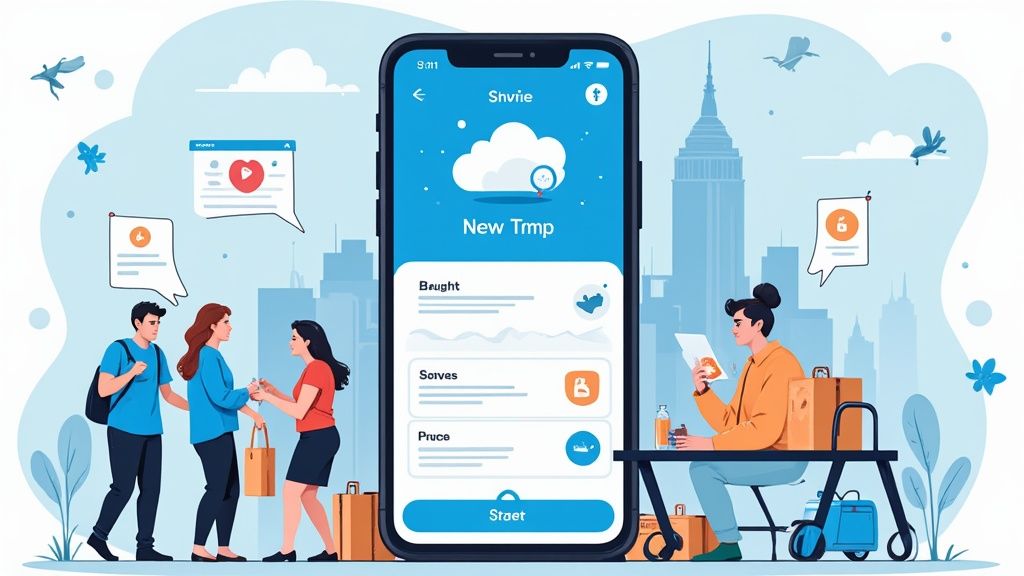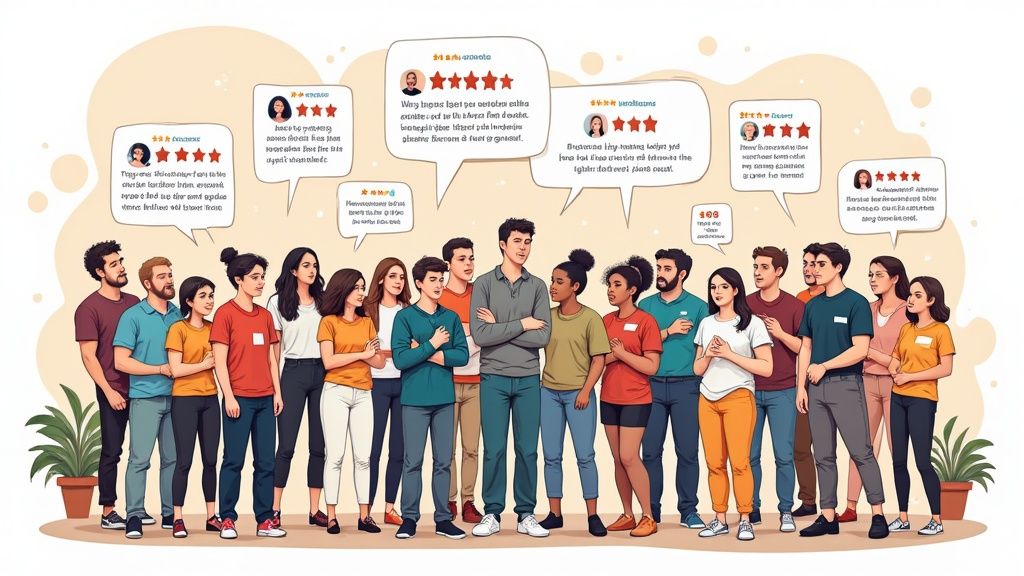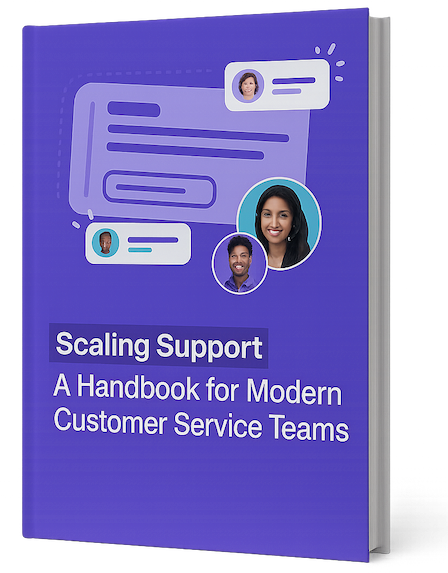The Real Business Impact of Customer Experience

Creating exceptional customer experiences directly impacts a company's bottom line and growth. When businesses make customer experience a priority, they see real financial benefits. Research shows that customers who have great experiences spend significantly more – up to 140% more compared to those who have negative experiences. This clear connection between customer satisfaction and spending demonstrates why investing in customer experience makes strong business sense.
Why Customer Experience Is a Competitive Advantage
Standing out in today's market requires more than just good products or services. According to studies, 81% of successful companies point to customer experience as their main competitive edge. This reflects how crucial positive customer interactions have become. What's more, 86% of buyers say they would pay extra for better customer experience – showing that customers truly value and reward companies that deliver outstanding service.
The Cost of Poor Customer Service
Bad customer service comes with a hefty price tag. US companies lose $1.6 trillion each year when customers switch to competitors after negative experiences. Even a single bad interaction can drive customers away – 32% say they would abandon a brand they like after just one poor experience. These numbers highlight why consistent, quality service is essential. Companies must build strong customer service capabilities and give their teams the tools and training to deliver excellent experiences every time.
How Successful Organizations Cultivate Great Customer Experiences
The best companies know that great customer experience requires focusing on several key areas. First, they emphasize quick response times since speed matters greatly to customers. They also make interactions personal – research shows 80% of customers actively seek personalized experiences. This means understanding individual preferences and needs to provide service that feels tailored to each customer.
Quality service must also be consistent across all touchpoints. Leading organizations maintain high standards whether customers reach out by phone, email, chat or in person. This reliability builds trust and shows customers they can count on great service every time. By excelling in responsiveness, personalization and consistency, companies create experiences that keep customers coming back and set themselves apart from competitors.
Building Lightning-Fast Response Systems That Actually Work

The ability to respond quickly to customers isn't just a nice-to-have feature anymore – it's essential for business success. Beyond simple message acknowledgments, companies need thoughtfully designed systems that enable consistently fast and helpful responses. The rapid shift in customer expectations around response times makes this more important than ever.
Why Speed Matters in Customer Experience
Recent research shows that speed is a top priority for customers, particularly younger demographics. A study found that 71% of consumers aged 16-24 directly connect rapid responses with better service experiences. Most customers now expect responses within 10 minutes, setting a challenging standard for support teams. This makes it critical for businesses to build response systems that can reliably meet these heightened expectations.
Practical Strategies for Implementing Efficient Responses
One effective approach is using smart tools to improve communication flows. For instance, ChatBot software can handle common questions instantly, allowing human agents to focus on more complex issues. But it's important to remember that technology should make human interactions better, not replace them entirely, since customers still value genuine personal connections.
Clear internal processes and empowered support teams are also key components. A tiered support structure works well – frontline staff handle straightforward requests while specialists tackle more involved problems. This helps customers get faster solutions while allowing support teams to work more effectively.
Balancing Speed with Quality: A Real-World Perspective
While quick responses matter, accuracy is just as important. A fast but incorrect answer can damage customer relationships as much as a slow response. Smart companies focus on delivering both speed and quality. Many support teams use internal knowledge bases that give agents quick access to accurate information, helping them provide fast and reliable answers.
Utilizing Technology for Enhanced Interaction
Tools that connect customer feedback directly to team communication platforms can significantly improve response effectiveness. For example, when support teams get immediate notifications about customer satisfaction ratings, they can quickly address any issues and make improvements. This creates a positive feedback loop between support teams and other departments, helping everyone understand how their work impacts customer satisfaction. By thoughtfully combining technology with efficient workflows, companies can create the balanced approach to speed and quality that defines truly excellent customer service.
Mastering the Art of Meaningful Personalization
Personalization has become essential for delivering exceptional customer experiences. Today's customers expect more than just products and services – they want interactions that feel personal and relevant to their specific needs. Recent studies show that 80% of customers actively seek personalized experiences, with tailored interactions driving spontaneous purchases up by 49%. These numbers highlight how personalization directly impacts both customer satisfaction and business growth.
Why True Personalization Matters
Real personalization goes deeper than just adding someone's name to an email. It requires understanding each customer's history with your business, anticipating what they might need next, and creating experiences that resonate with their unique situation. Think about receiving a generic gift card versus a thoughtfully chosen present that matches your interests perfectly – that's the difference between basic and meaningful personalization. This deeper approach builds lasting relationships that mass-market tactics simply can't achieve.
Practical Strategies for Authentic Personalization
Creating genuine personalized experiences requires combining human insight with the right technology. Here's how to make it work:
- Data Collection and Analysis: Gather key information about what customers prefer, what they've bought before, and how they browse your site. This forms the base for creating personal interactions.
- Segmented Communication: Group customers with similar traits so you can send messages that speak directly to their specific interests and needs.
- Personalized Recommendations: Use customer data to suggest products or services they're likely to want, based on their past choices and behavior.
- Dynamic Content: Adjust website content and offers in real-time as customers interact with your site, making each visit feel custom-made for them.
Maintaining Authenticity at Scale
While technology helps deliver personalization efficiently, keeping the human element is crucial. Too much automation can make interactions feel robotic and distant. The key is finding the right mix – use chatbots for simple questions, but have real people handle complex issues. SupportMan helps with this by connecting customer feedback directly to team communication in Slack, letting support teams respond quickly and naturally to customer needs. This approach helps support teams make informed decisions that feel personal while working efficiently. By empowering your team to make judgment calls within clear guidelines, you create genuine interactions that build strong customer relationships.
Creating Consistency That Keeps Customers Coming Back

While personalization and quick responses matter greatly in customer service, inconsistent quality can quickly undo all your hard work. Research shows that 32% of customers will stop supporting a brand they like after just one poor experience. So how can businesses deliver reliable, high-quality service that keeps customers returning time after time?
Building a Foundation of Consistent Service Excellence
Great customer service means delivering the same quality experience in every interaction – whether through phone, email, chat, or face-to-face. Think of your favorite coffee shop: you expect your latte to taste just as good each time, no matter who makes it. This predictable excellence builds customer confidence and reinforces your brand's value. That's why having clear service standards and making sure every team member understands them is essential.
Empowering Employees to Deliver Consistent Experiences
Your frontline staff shape how customers see your brand. The key is giving them the right resources and training to succeed. This includes access to detailed documentation and ongoing coaching about best practices, which helps them handle all kinds of situations confidently and consistently. Creating a culture where going above and beyond is encouraged also helps ensure service standards aren't just met but exceeded.
Monitoring and Maintaining Service Quality Over Time
Delivering great customer experiences requires constant attention and refinement. Regular tracking of key metrics like satisfaction scores and resolution times helps spot areas where service might be slipping. This data enables teams to proactively adjust processes and training. For instance, if customer feedback highlights recurring problems with a specific product or service, companies can address the root cause to prevent future issues and maintain consistently positive experiences.
Practical Frameworks for Monitoring and Maintaining Consistency
Several proven approaches help companies track and improve their customer experience consistency. Customer journey mapping visually outlines each step customers take when interacting with your brand, revealing potential problems and chances to enhance touchpoints. Regular feedback through surveys, reviews and social listening provides direct insight into real customer experiences. Tools like SupportMan can feed customer feedback straight into platforms like Slack, allowing support teams to respond quickly and spot emerging trends. This proactive approach to monitoring and improvement helps companies consistently meet customer needs while adapting to changing expectations.
Measuring What Actually Matters in Customer Experience
A great customer experience requires delivering consistent, personalized, and responsive service. But measuring the impact of these efforts can be challenging. Organizations need to focus on specific metrics that tell the real story behind customer satisfaction, going deeper than surface-level numbers. This section explores the key indicators and frameworks that help companies effectively gauge and improve their customer experience.
Beyond Vanity Metrics: Identifying Key Performance Indicators
While many companies track basic metrics like website visits or social followers, these numbers often fail to show the true picture of customer satisfaction. High traffic doesn't necessarily mean visitors are having good experiences or becoming loyal customers. Instead, companies should measure KPIs that directly connect to customer journeys and happiness:
- Customer Satisfaction Score (CSAT): Measures satisfaction with specific interactions or products through post-interaction surveys
- Net Promoter Score (NPS): Shows customer loyalty by asking how likely they are to recommend the company, helping predict future growth
- Customer Effort Score (CES): Focuses on ease of resolution or goal completion – lower scores typically indicate better experiences
- Churn Rate: Tracks percentage of customers who leave over time, with high rates potentially signaling experience problems
Utilizing the American Customer Satisfaction Index (ACSI) and Other Benchmarks
The American Customer Satisfaction Index provides valuable context for customer satisfaction trends nationally. With a Q3 2024 score of 77.9 (near historic highs) based on over 200,000 annual customer interviews, the ACSI helps companies benchmark against industry averages. By comparing their metrics against competitors and ACSI data, businesses can spot areas of excellence and improvement opportunities, setting realistic goals for enhancement.
Collecting Meaningful Feedback and Interpreting Data
Getting genuine customer feedback requires more than basic surveys. The key is asking targeted questions about specific touchpoints to gather actionable insights. For example, after customer service interactions, focus on agent helpfulness and resolution speed. Qualitative feedback through open-ended questions and reviews reveals deeper insights into customer motivations. Tools like SupportMan can help by connecting feedback directly to team communication platforms like Slack, enabling faster responses and trend identification.
Frameworks for Continuous Improvement
Successfully implementing changes based on data requires a structured approach. The Plan-Do-Check-Act (PDCA) cycle provides an effective framework: First, plan improvements based on data analysis. Then implement changes on a small scale. Next, measure the impact on relevant KPIs. Finally, either standardize successful changes or refine the approach further. This ongoing cycle helps companies adapt to evolving customer needs while optimizing their customer experience efforts.
Building a Future-Proof Customer Experience Strategy

What makes customers happy keeps changing. A service experience that delights customers today might feel basic or inadequate tomorrow. Forward-thinking companies know they need to stay ahead by understanding where customer needs are headed. This means building a strong foundation through customer-focused culture, smart technology choices, and ongoing improvements based on feedback.
Adapting to Evolving Customer Expectations
Today's customers have easy access to information and many options to choose from. They want personalized service that feels consistent whether they're on their phone, computer, or talking to support. For instance, a customer might research a product on mobile, buy it on their laptop, and later get help through chat. To deliver this seamless experience, companies need well-trained teams and connected systems that share customer information across channels. This helps staff provide relevant, high-quality support at every step.
The Human Touch in a Digital World
While good technology is essential, genuine human connection matters more than ever. When customers face complex problems or have complaints, they value empathy and understanding from real people. Research shows 80% of customers prefer companies that make their experience feel personal. But this goes beyond just using someone's name – it means truly getting to know customers' needs and empowering support teams to build authentic relationships through meaningful conversations.
Building a Customer-Centric Culture
Great customer experience starts from within the company. Every employee needs to understand how their work affects customer happiness, regardless of their role. Regular training helps build crucial skills like empathy, listening, and creative problem-solving. Teams should regularly discuss customer feedback and success stories in meetings. This helps everyone see the direct link between their efforts and customer satisfaction. When customer focus becomes part of daily conversations, it shapes how people think about and approach their work.
Scaling Service Excellence
As companies grow, keeping service quality high becomes harder. Smart use of the right tools makes a big difference. SupportMan helps teams communicate better and understand how customers really feel. By connecting customer feedback to tools like Slack, teams can respond quickly when issues come up. This immediate feedback shows what's working well and what needs fixing. Regular quality checks also help ensure service stays strong as the company expands.
Ready to improve your customer experience and build lasting loyalty? Start your free trial of SupportMan today and see the difference real-time feedback can make: https://supportman.io


